
Eleven Historic Michigan Sites Added to National Register of Historic Places
State Historic Preservation Office (SHPO)
Tuesday, February 18, 2025
Administered by the State Historic Preservation Office, the recognition highlights the historic significance of sites across the state of Michigan
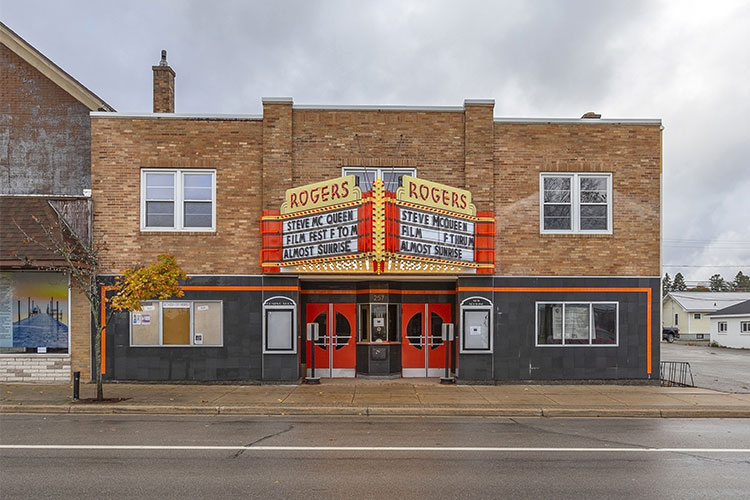
LANSING, Mich. – Eleven historic Michigan properties were given special recognition in 2024 through their listing in the National Register of Historic Places, the Michigan Economic Development Corporation (MEDC) has announced. Administered in Michigan by the State Historic Preservation Office (SHPO), the National Register of Historic Places is the United States federal government's official list of districts, sites, buildings, structures, and objects deemed worthy of preservation for their historical significance.
"Every year the SHPO has the privilege of working with numerous communities and individuals throughout the state to elevate Michigan sites to the National Register of Historic Places,” said State Historic Preservation Officer Ryan Schumaker. “The SHPO is pleased to announce these eleven properties have been added to the National Register, highlighting the state's diverse cultural and architectural legacy. From a small-town theater up north to an adaptively reused former post office, and a big city plaza envisioned by a renowned Japanese American landscape designer, the historic properties listed in 2024 illustrate a rich and diverse history at the local, state, and national levels. Listing in the National Register opens opportunities for economic investment in these communities and ensures that significant places from the past remain relevant into the future.”
More than 96,000 properties across the country, including nearly 2,000 in Michigan, have been listed in the National Register since the program began in the 1960s. The National Register is a program of the National Park Service and is administered by the states.
Each place listed in the National Register is referred to as a “property,” whether it is a single building, site, or structure or a historic district composed of hundreds of individual buildings. To be considered for listing in the National Register, a property must generally be at least 50 years old and must also be significant when evaluated in relationship to major historical events or trends in the history of their community, the state, or the nation. A property must also possess historic integrity – the ability to convey its significance.
The following Michigan properties were among those listed in the National Register in 2024:
|
Municipality |
Property Name |
County |
|
Buchanan |
Oak Ridge Cemetery |
Berrien |
|
Caro |
William and Lovila Moore House |
Tuscola |
|
Coldwater |
Capri Drive-In Theatre |
Branch |
|
Detroit |
Detroit Association of Women's Clubs |
Wayne |
|
Detroit |
Philip J. Hart Plaza |
Wayne |
|
Detroit |
Millwood Apartments |
Wayne |
|
Jackson |
Hayes Hotel |
Jackson |
|
Lansing |
Washington Apartments |
Ingham |
|
Plymouth |
U.S. Post Office Plymouth Station |
Wayne |
|
Rogers City |
Rogers Theatre |
Presque Isle |
|
Vicksburg |
Vicksburg Union Depot |
Kalamazoo |
“The common thread that runs through these historic places is the idea of community,” said National Register Coordinator Todd Walsh. “These are places where we come together as family, friends, and neighbors to celebrate, to laugh, to share, and even to mourn; places where we say hello and goodbye. Each of these places is a reflection of our shared history and humanity. They tell us the stories of our past and have the power to bring us together as Michiganders.”
To obtain copies of any of these National Register nominations or high-resolution photos, contact preservation@michigan.gov.
Listing of a property in the National Register is honorary and places no restrictions on what a property owner may do. They are not required to open the site to the public nor to display a plaque acknowledging the listing, although many companies offer plaques to recognize the hard work and effort to get a property officially listed. In addition, listing in the National Register provides opportunities for promotion, makes available certain incentives like grants and tax credits that foster investment in our cities, towns, and villages, and allows for the consideration of historic resources when federal funding or permits are involved.
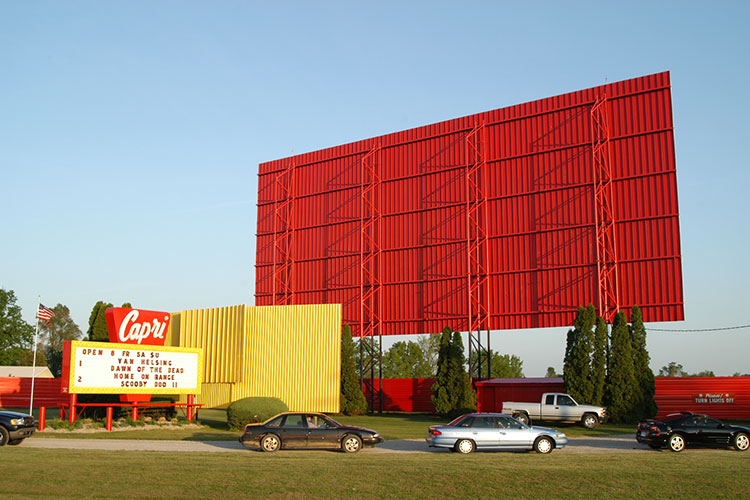
The show goes on at small town theaters in Coldwater and Rogers City
Situated along historic Highway U.S. 12, the Capri Drive-In Theater near Coldwater is Michigan’s first drive-in listed in the Register. It opened in 1964 with a single screen during the height of the “drive-in craze.” The theater could accommodate over 800 autos for twilight showings from April through November, and included a playground for children and concessions stand. A second screen was relocated from a defunct drive-in near Detroit and added to the Capri property in the 1980s. Today, the signature neon Capri sign along the highway and the ticket booth, concessions stand and Screen 1 are all the original 1964 design, giving theater-goers an authentic ambience from the past.
The legacy of the theater itself is matched by the legacy of the family that runs it. The Capri was the vision of John and Mary Magocs, who sold their Detroit-area business to finance the building of the theater and turn their passion for movies into a full-time career. Son Tom Magocs and his wife Susan run the theater today with the help of their kids. Their continued investments in technology – from AM radio sound in the early days to FM stereo today and making the switch to digital projection – have ensured the Capri remains a regional destination. People drive to the Capri from all over southern Michigan, and nearby northern Indiana, too.
At the opposite end of the lower peninsula, the Rogers Theater in Rogers City also continues to offer entertainment to a regional audience under the ownership of Presque Isle District Library. Built in 1937 in the Art Moderne style, this single screen cinema has shown first-run movies to generations of movie-goers. The Vogelheim Family rebuilt and ran the theater after a devasting fire in 1948, then in 2003, Karl and Mary Heidmann acquired the theater. A stage was built for live musical and community theater performances while retaining the screen to continue to show films and local library programming. The long-term vision was that it would be an arts and culture hub for this region in northern Michigan.
In 2016, the Rogers Theater was gifted to the Presque Isle District Library. This would permit the library to fully incorporate the theater into its community programming and give the building non-profit status which would allow for the pursuit of grants and other funding opportunities. In 2023, the Presque Isle District Library was awarded a Resilient Lakeshore Heritage Grant from the Michigan SHPO to restore the iconic marquee, which suffered from years of electrical problems and a lack of available parts. Also, part of the grant award was to complete the listing of the theater in the National Register. Today, the Rogers Theater is one of the few performance venues in the state operated by a public library, offers first-run and classic movies, community and youth theater, and as an event rental venue in northeast Michigan. It’s a unique but highly successful blueprint for offering more opportunities to a small-town community.
“It makes sense that two of the oldest cultural institutions in history merge in rural America and complement each other to promote our social, intellectual and cultural history,” said Library Director Amber Alexander of Presque Isle District Library. “To have both institutions exist and thrive can be challenging in our digital world, and being recognized by the National Register undoubtedly confirms the legacy of libraries/theaters is still strong and deserves continuing archival and physical preservation.”
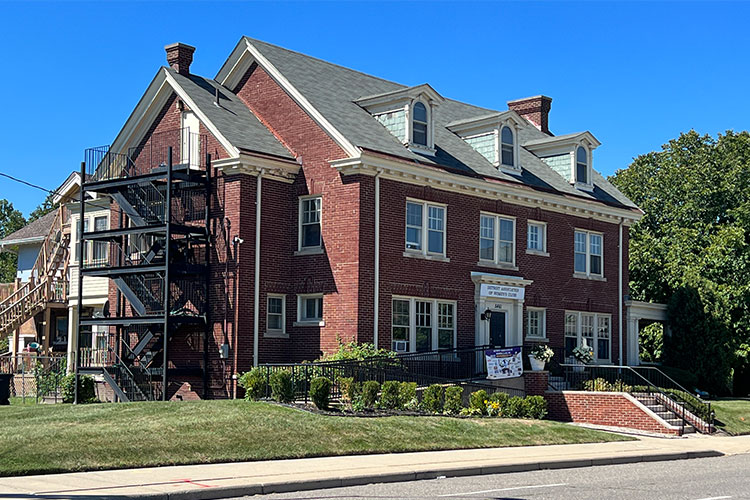
Detroit Association of Women’s Clubs, Detroit
An important emphasis in the National Register program is the documentation of sites related to historically underrepresented communities. The Detroit Association of Women's Clubs (DAWC) Building is significant in the areas of Black Ethnic History and Civil Rights history as an important social institution and social organization for Black women’s clubs in Detroit, and for its association with civil rights leader Dr. Rosa Slade-Gragg. The DAWC was founded in 1921 to promote charitable, educational, religious, social activities, and community uplift, and to aid in the solution of racial problems. Twenty years later, their success led them to seek their own headquarters location, and this house at the corner of East Ferry Avenue and Brush Street became available. At the time, a racially restrictive housing covenant made it illegal for an African American to own property on this particular block of East Ferry. Club president Dr. Slade-Gragg came up with the creative solution to brick up the entrance facing Ferry Street and have the address changed to Brush Street, which did not have such a restrictive covenant.
Evidence of this original entrance can still be seen in the brickwork beneath the columned porch roof facing Ferry Street. Beyond her eighteen years of leadership as the president of the DAWC, Dr. Rosa Slade-Gragg was appointed by Presidents Roosevelt, Kennedy, and Johnson to serve on national commissions focused on aiding underrepresented communities and served for five years as the president of the National Association of Colored Women’s Clubs. The building continues to serve as the headquarters of the Detroit Association of Women's Clubs, a women-focused non-profit dedicated to community advancement through outreach for all ages.
“The members of the DAWC are deeply honored and grateful for the recognition of the Detroit Association of Women’s Clubs, Incorporated on the National Register of Historic Places,” said Executive Director Candace M. Calloway. “This acknowledgment not only celebrates the historical significance of our work but also highlights the collective efforts of our community, supporters, and partners who have made this achievement possible. We are committed to preserving both Dr. Rosa Slade Gragg’s legacy and continuing our organization’s mission to inspire and serve future generations of women in Detroit. This is an incredible honor.”
An Early “Smart” Home – William and Lovila Moore House, Caro
William Moore was born in Ontario in 1870 but grew up in Michigan’s Thumb region. Fascinated by the changing technology of the era and with an innovative mind, Moore designed and patented a telephone transmitter, followed by a switchboard. He founded a company to produce his designs and established the Moore Telephone System, which starting in 1892 provided the first telephone service to several Thumb communities. He owned the first automobile in the Thumb and later in life owned a collection of early and unique cars.
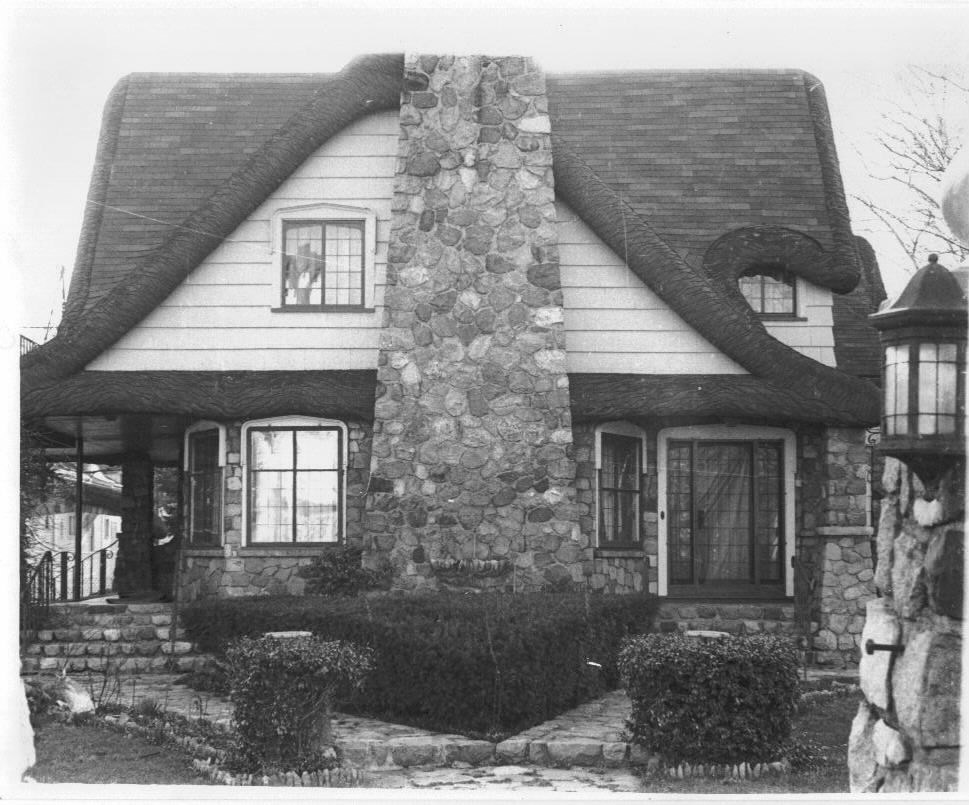 His inventive mind wasn’t just limited to telephones. In the 1920s, the Moores undertook an extensive renovation of their home in Caro, transforming it into a storybook Tudor Revival style home with an unusual false thatched roof and rolled eaves, reminiscent of an English cottage. The interior was extensively retrofitted with William’s electronic inventions, such as a burglar alarm, automatic garage and entry doors, and a telephone in every room! The home became a showplace for him to market his products and the grounds became a beloved community landmark thanks to the substantial in-ground swimming pool constructed beside the house which he opened in the summers for children and adults alike to enjoy.
His inventive mind wasn’t just limited to telephones. In the 1920s, the Moores undertook an extensive renovation of their home in Caro, transforming it into a storybook Tudor Revival style home with an unusual false thatched roof and rolled eaves, reminiscent of an English cottage. The interior was extensively retrofitted with William’s electronic inventions, such as a burglar alarm, automatic garage and entry doors, and a telephone in every room! The home became a showplace for him to market his products and the grounds became a beloved community landmark thanks to the substantial in-ground swimming pool constructed beside the house which he opened in the summers for children and adults alike to enjoy.
“The Moore family is extremely proud of the National Register of Historic Places designation on our family's historic home – a futuristic home in the 1920s and a historic home in the 2020s,” said homeowner and Moore family member Steven Shields. “The great-great grandson of W. J. Moore brought the home back into the family, and we are all working to bring back more of the home's majestic character. So many of W. J.’s forward-thinking innovations are being re-discovered and shared with not only the younger family members, but the community as well. We are honored to take this house into its next century of life.”
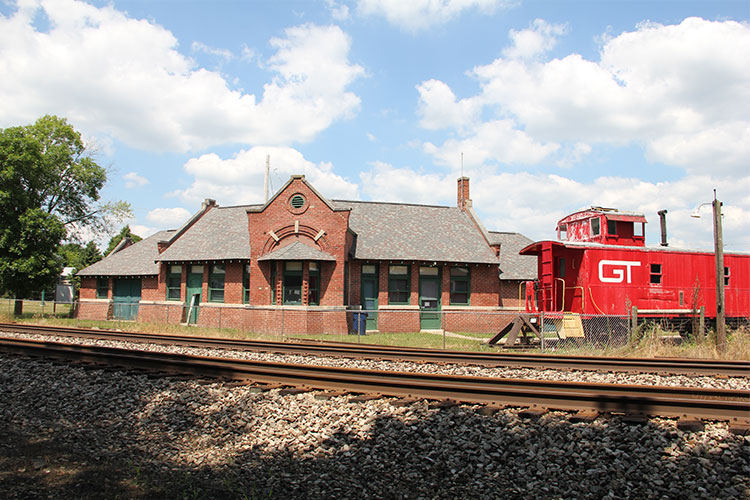
All Aboard at the Vicksburg Union Depot
Each National Register-listed property is significant in its own way, representing important aspects of local, state, or national history. But occasionally, a newly designated site is itself the actual home for a community’s own history! The Vicksburg Union Depot opened in 1904 at an important railroad junction where two lines crossed in southern Kalamazoo County. Grand Rapids-based architects Williamson & Crow designed the high style building to be a point of welcome for out-of-town travelers. Vicksburg residents were connected by train to Lansing, Chicago, Mackinaw City, and even Canada. It was the hub of community activity.
As travel preferences changed, passenger trains declined, and the last train left the depot in 1971. The Village of Vicksburg later acquired the depot and, after a series of renovations, reopened it as the home of the Vicksburg Historical Society and the gateway to the Vicksburg Historic Village, a collection of historic and recreated buildings representing life in the community from the 1890s-1930s. The depot interior is restored to showcase the busy years of the railroads in Vicksburg through exhibits and artifacts. Outside, visitors can tour several pieces of railroad equipment including a caboose where a railroad track once ran or stand at the fence and marvel at a real freight train rolling by on the main line.
“The National Register recognition of the Vicksburg Union Depot is a remarkable achievement for our small community,” said Leah Milowe, museum administrator and curator at the Vicksburg Historical Society and Historic Village. “Beyond the unique architecture and historical significance of the Vicksburg Union Depot, I see this designation as a testament to the dedicated volunteers who preserved the building and transformed it into a community museum and cornerstone of Vicksburg history. With their hard work and this recognition, it is my hope that the Depot continues to impress visitors with its architectural charm and spark memories, both old and new.”
Follow the Michigan SHPO Instagram channel to stay up to date on the latest National Register listings in Michigan in 2025.
For more information about the National Register of Historic Places program in Michigan, and how to learn if your property might be eligible for listing in the National Register, visit https://www.michigan.gov/nrhp.
About the State Historic Preservation Office
Focused on the historic preservation of culturally or archaeologically significant sites throughout the state, Michigan's State Historic Preservation Office’s main function is to provide technical assistance to local communities and property owners in their efforts to identify, evaluate, designate, interpret and protect Michigan’s historic above- and below-ground resources. SHPO also administers an incentives program that includes state and federal tax credits and pass-through grants available to Certified Local Governments.
To learn more about the State Historic Preservation Office and the Certified Local Government program, visit https://www.miplace.org/historic-preservation/.
About Michigan Economic Development Corporation (MEDC)
The Michigan Economic Development Corporation is the state’s marketing arm and lead advocate for business development, job awareness and community development with the focus on growing Michigan’s economy. For more information on the MEDC and our initiatives, visit www.MichiganBusiness.org. For Pure Michigan® tourism information, your trip begins at www.michigan.org. Join the conversation on: Facebook Instagram LinkedIn, and Twitter.
Recent Press Releases

